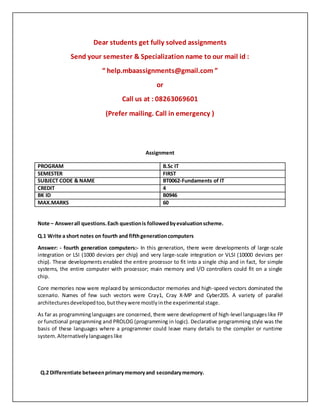
Bt0062 fundamentals of it-de
- 1. Dear students get fully solved assignments Send your semester & Specialization name to our mail id : “ help.mbaassignments@gmail.com ” or Call us at : 08263069601 (Prefer mailing. Call in emergency ) Assignment PROGRAM B.Sc IT SEMESTER FIRST SUBJECT CODE & NAME BT0062-Fundaments of IT CREDIT 4 BK ID B0946 MAX.MARKS 60 Note – Answer all questions. Each question is followed by evaluation scheme. Q.1 Write a short notes on fourth and fifth generation computers Answer: - fourth generation computers:- In this generation, there were developments of large-scale integration or LSI (1000 devices per chip) and very large-scale integration or VLSI (10000 devices per chip). These developments enabled the entire processor to fit into a single chip and in fact, for simple systems, the entire computer with processor; main memory and I/O controllers could fit on a single chip. Core memories now were replaced by semiconductor memories and high-speed vectors dominated the scenario. Names of few such vectors were Cray1, Cray X-MP and Cyber205. A variety of parallel architectures developed too, but they were mostly in the experimental stage. As far as programming languages are concerned, there were development of high-level languages like FP or functional programming and PROLOG (programming in logic). Declarative programming style was the basis of these languages where a programmer could leave many details to the compiler or runtime system. Alternatively languages like Q.2 Differentiate between primary memory and secondary memory.
- 2. - Primary memory:- 1) Primary storage, also known as main storage or memory, is the area in a computer in which data is stored for quick access by the computer's processor. The terms random access memory (RAM) and memory are often as synonyms for primary or main storage. Primary storage is volatile and can be contrasted with non-volatile secondary storage, also known as auxiliary storage. The terms main storage and auxiliary storage originated in the days of the mainframe computer to distinguish the more immediately accessible data storage Q.3 what is cache memory? Explain the importance of cache computer memory. Answer: - cache memory:- A CPU cache is a cache used by the central processing unit (CPU) of a computer to reduce the average time to access data from the main memory. The cache is a smaller, faster memory which stores copies of the data from frequently used main memory locations. Most CPUs have different independent caches, including instruction and data caches, where the data cache is usually organized as a hierarchy of more cache levels. Overview:- When the processor needs to read from or write to a location in main memory, it first checks whether a copy of that data is in the cache. If so, the processor immediately reads from or writes to the cache, which is much faster than reading from or writing to main memory. Most modern desktop and server CPUs have at least Q.4 Write the steps to insert one or more columns and one or more cells in MS Excel. Answer: - steps to insert one or more columns and one or more cells in MS Excel:- Step 1:-
- 3. Insert Cells into an Excel Worksheet Having to insert extra cells to an Excel worksheet from time to time is a common practice: data gets forgotten and must be added, space must be made for new data, or existing data gets moved about when the sheet is reorganized. Q.5 What is sound multimedia? Explain common sound file formats? Answer: - sound multimedia:- Sound is perhaps the most sensuous element of multimedia. It is meaningful "Speech" in any language from a whisper to a scream. It can provide the listening pleasure of music, the startling accent of special effects, or the ambience of a mood-setting background. How you use the power of sound can make the difference between an ordinary multimedia presentation and a professionally spectacular one Common sound file formats:- An audio file format is a file format for storing digital audio data on a computer system. The bit layout of the audio Q.6 What is Internet? What is the use of it Internet in the modern world. Answer: - Internet:- The Internet is a global system of interconnected computer networks that use the standard Internet protocol suite (TCP/IP) to link several billion devices worldwide. It is an international network of networks that consists of millions of private, public, academic, business, and government packet switched networks, linked by a broad array of electronic, wireless, and optical networking technologies. The Internet carries an extensive range of information resources and services, such as the inter-linked hypertext documents and applications of the World Wide Web (WWW), the infrastructure to support email, and peer-to-peer networks for file sharing and Dear students get fully solved assignments Send your semester & Specialization name to our mail id : “ help.mbaassignments@gmail.com ”
- 4. or Call us at : 08263069601 (Prefer mailing. Call in emergency )
